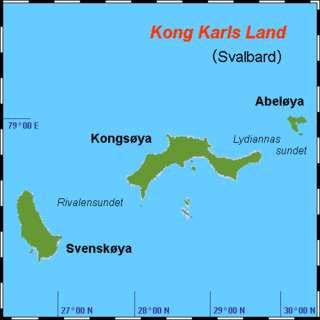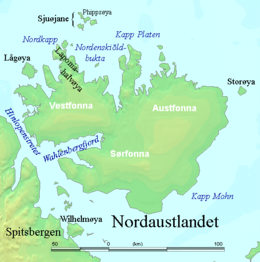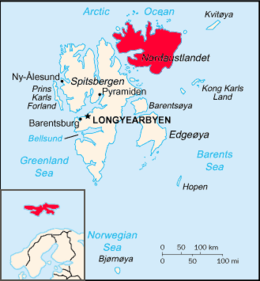
Svalbard, previously known as Spitsbergen or Spitzbergen, is a Norwegian archipelago in the Arctic Ocean. North of mainland Europe, it lies about midway between the northern coast of Norway and the North Pole. The islands of the group range from 74° to 81° north latitude, and from 10° to 35° east longitude. The largest island is Spitsbergen, followed in size by Nordaustlandet and Edgeøya. The largest settlement is Longyearbyen on the west coast of Spitsbergen.

Svalbard is an archipelago in the Arctic Ocean roughly centered on 78° north latitude and 20° east longitude. It constitutes the northernmost territory of the Kingdom of Norway. The three main islands in the group consist of Spitsbergen, Nordaustlandet and Edgeøya. There are also a number of smaller islands, such as Barents Island (Barentsøya), Kvitøya, Prins Karls Forland, Kongsøya, Bear Island, Svenskøya, Wilhelm Island and other smaller islands or skerries.

Edgeøya, anglicised as Edge Island, is a Norwegian island located in southeast of the Svalbard archipelago; with an area of 5,073 square kilometres (1,960 sq mi), it is the third-largest island in this archipelago. An Arctic island, it forms part of the Søraust-Svalbard Nature Reserve, home to polar bears and reindeer. An ice field covers its eastern side. The island takes its name from Thomas Edge, an English merchant and whaler. It is seldom visited today and development of tourist facilities is forbidden by law because of its nature reserve status.

Barentsøya, anglicized as Barents Island, is an Arctic island in the Svalbard archipelago of Norway, lying between Edgeøya and Spitsbergen. To the north, in the sound between Barentsøya and Spitsbergen, lies the island of Kükenthaløya. To the south, the sound separating Barents Island from Edgeøya is Freemansundet.

Kong Karls Land or King Charles Land is an island group in the Svalbard archipelago, in the Arctic Ocean. The island group covers an area of 342 km2 (132 sq mi) and is made up of the islands of Kongsøya, Svenskøya, Abel Island, Helgoland Island, and Tirpitzøya.

Danes Island is an island in Norway's Svalbard archipelago in the Arctic Ocean with an area of 40.6 km2 (15.7 sq mi). It lies just off the northwest coast of Spitsbergen, the largest island in the archipelago, near to Magdalenefjorden. Just to the north lies Amsterdam Island. Most of Svalbard's islands, including Danes Island, are uninhabited; only Spitsbergen, Bjørnøya and Hopen have settlements.

Austfonna is an ice cap located on Nordaustlandet in the Svalbard archipelago in Norway. Covering an area of 7,800 km2, it is Europe's third-largest glacier by area and volume, after the Severny Island ice cap of Novaya Zemlya, Russia, and Vatnajökull in Iceland. The combined area of Austfonna and the Vegafonna ice cap is 8,492 km2.

Victoria Island is a small Arctic island of the Russian Federation. It is located at 80°9′N36°46′E, halfway between the Norwegian archipelago of Svalbard and the Russian archipelago of Franz Josef Land.

Olav V Land is a peninsula in eastern Spitsbergen Island, Svalbard named after Olav V of Norway. It is covered by the Olav V Icefield, measuring about 4,150 square kilometres (1,600 sq mi).

Lågøya is an island in Svalbard, Norway. It is situated north west of Nordaustlandet. The area is 103.5 km2. The island has rarely been visited.

Vestfonna is an ice cap located on the western part Nordaustlandet in the Svalbard archipelago in Norway. The glacier covers an area of about 2,500 km2. It is the third largest ice cap in Svalbard and Norway by area, after Austfonna and Olav V Land.

Nordaust-Svalbard Nature Reserve is located in the north-eastern part of the Svalbard archipelago in Norway. The nature reserve covers all of Nordaustlandet, Kong Karls Land, Kvitøya, Sjuøyane, Storøya, Lågøya, Wilhelm Island, Wahlbergøya and a small section of the north-east corner of Spitsbergen. The reserve is 55,354 square kilometres (21,372 sq mi), of which 18,663 square kilometres (7,206 sq mi) is on land and 36,691 square kilometres (14,166 sq mi) is on water—making it the largest preserved area in Norway. It includes the largest glacier in Norway, Austfonna, as well as Vestfonna and parts of Olav V Land. The reserve has been protected since 1 July 1973 and borders in the south to Søraust-Svalbard Nature Reserve.
Svalbard is an Arctic, wilderness archipelago comprising the northernmost part of Norway. It is mostly uninhabited, with only about 3,000 people, yet covers an area of 61,020 square kilometres (23,560 sq mi).

Gustav V Land is a land area comprising the peninsula on the northwestern part of Nordaustlandet, Svalbard in Arctic Norway. It constitutes roughly one quarter of the island's area, approximately 4000 km2, being some 80 km wide east–west and 85 km north–south, connected to the rest of the island by a 22-km-wide isthmus in the southeast. The peninsula is bordered to the south by Wahlenbergfjorden, to the west by Hinlopen Strait and Hinlopenrenna, to the north by Nordkappsundet, and to the east by Nordenskiöldbukta and Rijpfjorden. Gustav Adolf Land is to the south and Prins Oscars Land is to the east. The boundary of Gustav V Land passes through Rijpdalen and Flaumdalen to Winsnesbreen in the east, continues further southwest to Brånevatnet, and thence follows the river from Brånevatnet to the sea at Bodleybukta. The highest elevation is 630 metres (2,070 ft) on the glacier Vestfonna, which covers large parts of the land.

Wahlbergøya is an island in Hinlopen Strait, between Spitsbergen and Nordaustlandet of the Svalbard archipelago. The island has an area of about 48 km2 (19 sq mi). The islands highest point is 194 m.a.s.l. Named after Swedish botanist Peter Fredrik Wahlberg. It is the largest island of Vaigattøyane.
Isispynten is the most eastern point of Isisøyane, east of Nordaustlandet, Svalbard. It was earlier regarded as a headland of Nordaustlandet, but after the retreat of Austfonna, it became apparent that the point was on a separate small island.
Isisøyane is a group of small islands east of Nordaustlandet, Svalbard. They were earlier regarded to be part of Nordaustlandet, an ice free point named Isispynten. After the retreat of Austfonna, the islands appeared as islands. They were named Isisøyane in 2009.
Norddomen is an ice dome of Austfonna at Nordaustlandet, Svalbard. The glacier cap of Austfonna has two significant ice domes, Norddomen and Sørdomen further south. Norddomen is the highest point of Nordaustlandet, with a height of about 700 m.a.s.l.













